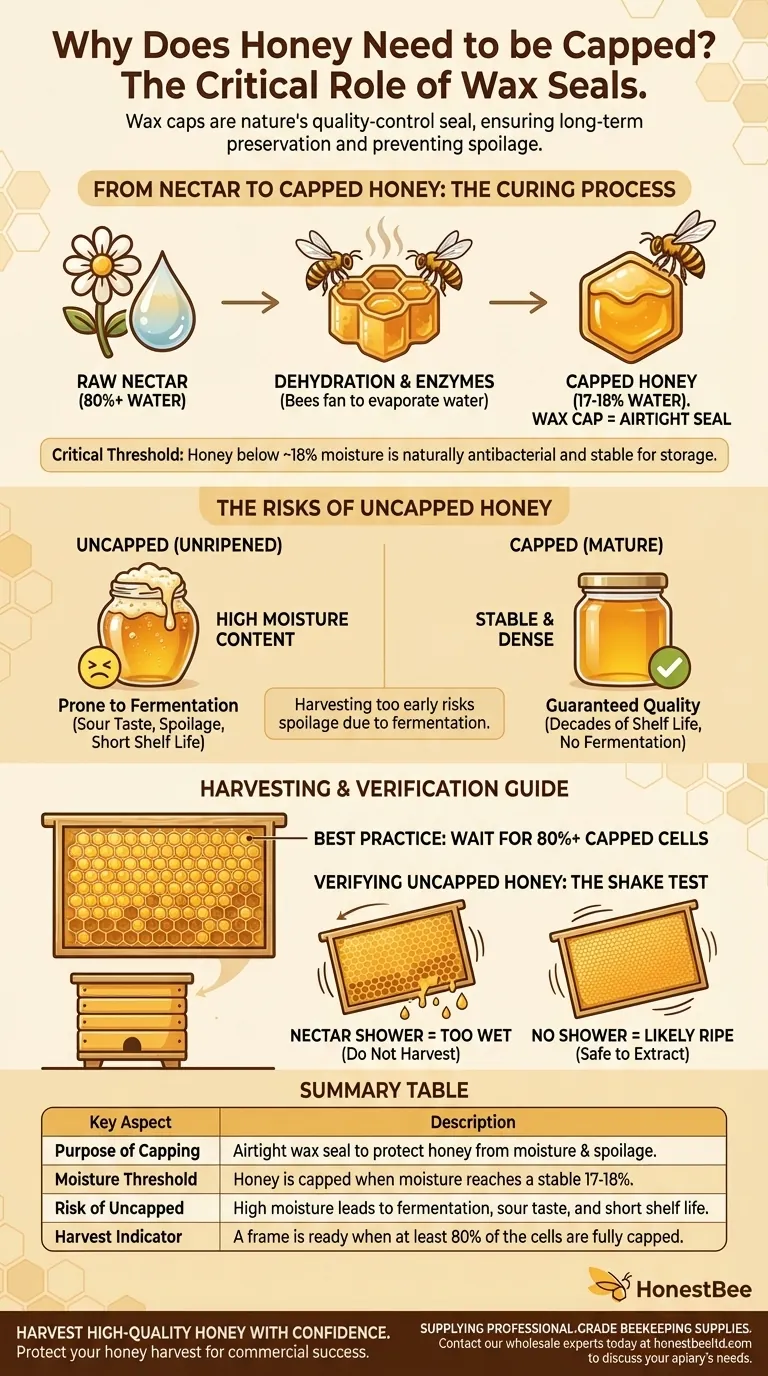Honey is capped by bees once it has been dehydrated to the correct moisture content. This wax cap acts as a final seal, protecting the honey from absorbing atmospheric moisture and preventing it from spoiling through fermentation. It is the bees' signal that the honey is "ripe" and stable for long-term storage.
The wax cap on a honeycomb is essentially a quality-control seal. It signifies that the bees have finished the process of turning watery nectar into dense, stable honey that will not ferment, ensuring its preservation.

From Nectar to Honey: The Curing Process
To understand the importance of capping, you must first understand how bees create honey. It's a deliberate process of conversion and dehydration.
The Problem of High Moisture Content
Bees begin by collecting nectar from flowers. This raw material is not honey; it's a sugary liquid that is often more than 80% water.
If stored in this state, the high moisture content would allow naturally occurring yeasts to thrive, causing the mixture to ferment and spoil.
How Bees Dehydrate the Nectar
Inside the hive, bees work to reduce the water content. They pass the nectar from bee to bee, adding enzymes, and deposit it into the honeycomb cells.
The colony then actively fans its wings over the open cells, creating airflow that evaporates excess water from the nectar.
The Critical Moisture Threshold
This fanning process continues until the moisture content of the honey drops to a stable level, typically around 17-18%.
Below this threshold, the honey is too dense for yeast and other microbes to grow, making it naturally antibacterial and shelf-stable.
The Final Seal: Wax Capping
Once the honey has reached this ideal low-moisture state, the bees create a thin layer of fresh beeswax to cap the cell.
This cap is an airtight seal. It prevents the finished honey from reabsorbing moisture from the air and protects it from impurities until the bees need it for food.
Understanding the Risks: Harvesting Uncapped Honey
For a beekeeper, the presence of a wax cap is the most reliable indicator that the honey is ready for harvest. Harvesting too early comes with significant risks.
The Danger of Fermentation
Harvesting uncapped, or "unripened," honey means you are extracting a product that is too watery.
Even if it looks like honey, the high moisture content makes it prone to fermentation. This will give the honey a sour, alcoholic taste and a frothy appearance, rendering it unusable.
Verifying if Uncapped Honey is Ready
Sometimes a frame is mostly capped but has some open cells. To check if the uncapped honey is also ripe, you can perform a shake test.
Hold the frame horizontally over the hive and give it a firm shake. If a shower of nectar flies out, the honey is too wet. If nothing comes out, it is likely close to the correct moisture level and safe to extract.
The Impact on Quality and Shelf Life
Properly cured and capped honey can last for decades, or even centuries, without spoiling. Honey harvested prematurely will have a very short shelf life and inferior quality.
The cap is your guarantee of a dense, high-quality product that will store properly.
Making the Right Choice for Your Harvest
The decision of when to harvest directly impacts the quality and longevity of your honey. Trusting the bees' signal is the best practice.
- If your primary focus is maximum quality and long-term storage: Wait until at least 80% of the cells on a frame are fully capped before you consider harvesting.
- If your primary focus is harvesting a partially capped frame: Use the shake test on the uncapped sections to avoid introducing high-moisture nectar that could spoil your entire batch.
Ultimately, the wax cap is the final step in a natural process of preservation, ensuring the honey is perfect.
Summary Table:
| Key Aspect | Description |
|---|---|
| Purpose of Capping | Airtight wax seal to protect honey from moisture and spoilage. |
| Moisture Threshold | Honey is capped when moisture content reaches a stable 17-18%. |
| Risk of Uncapped Honey | High moisture leads to fermentation, sour taste, and short shelf life. |
| Harvest Indicator | A frame is ready when at least 80% of the cells are fully capped. |
Harvest High-Quality Honey with Confidence
Protecting your honey harvest from spoilage is critical for commercial success. At HONESTBEE, we supply professional-grade beekeeping supplies and equipment to commercial apiaries and distributors. Our durable, efficient tools—from uncapping knives to honey extractors—are designed to help you maximize yield and maintain the superior quality of your capped honey.
Let's ensure your next harvest is your best one yet. Contact our wholesale experts today to discuss your apiary's needs.
Visual Guide

Related Products
- Precision Honey Refractometer Instrument for Quality Assessment
- Professional Thermostatic Conical Honey Melter
- Honey Concentrating Vacuum Heating Thickening Machine Dehumidifier for Honey
- 0.5T Capacity Honey Dehumidifier Dryer with Vacuum Heating and Thickening Filtering Machine
- Plastic Hand Crank 2 Frame Honey Extractor Low Price
People Also Ask
- Why is a honey refractometer important for beekeepers? Ensure Quality and Prevent Fermentation
- What are the features of the Standard Refractometer for honey moisture content? Essential Tools for Quality Control
- What is a honey refractometer and what is its purpose? Ensure Honey Quality and Prevent Spoilage
- What are the key steps to using a honey refractometer? Ensure Honey Quality & Prevent Fermentation
- How does a honey refractometer work? Ensure Honey Quality & Harvest Readiness



















